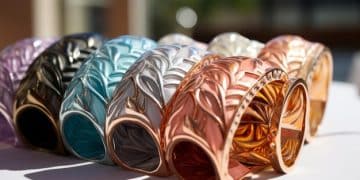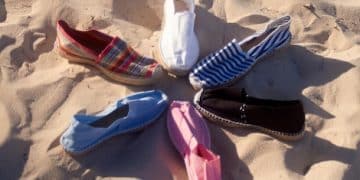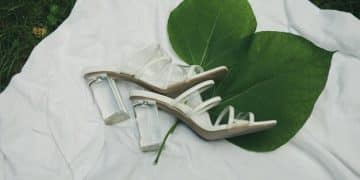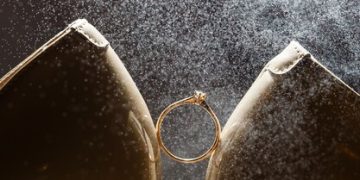Designer Shoe Materials: Leather, Suede & Beyond
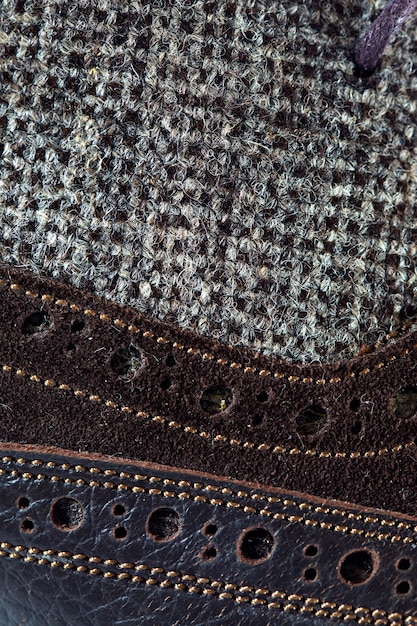
Understanding the diverse materials used in luxury footwear, such as leather, suede, and exotic skins, is crucial for appreciating the craftsmanship, durability, and unique characteristics that define high-end designer shoes.
Stepping into the world of luxury footwear reveals a meticulous blend of art and engineering, where every stitch and curve speaks volumes. For those who appreciate the finer things, understanding The Complete Guide to Designer Shoe Materials: Leather, Suede, and More is not just about fashion; it’s about discerning quality, longevity, and ethical craftsmanship. This exploration delves into the foundational elements that elevate a pair of shoes from mere accessories to coveted investments.
the foundation: classic leather
Leather remains the cornerstone of luxury footwear, prized for its durability, flexibility, and the way it ages gracefully. Its versatility allows designers to craft myriad styles, from sleek dress shoes to robust boots, each with a unique character.
The journey of leather begins long before it reaches the designer’s atelier. It involves a meticulous tanning process, transforming raw hides into a pliable, long-lasting material. The specific tanning method significantly influences the leather’s final appearance, texture, and performance characteristics, making it essential for designers to select the right type for their vision.
full-grain leather: the epitome of quality
Often considered the highest quality leather, full-grain retains the entire grain, including imperfections, which tell the story of the animal’s life. This natural surface makes it incredibly durable and resistant to moisture, developing a rich patina over time that enhances its beauty.
- durability: Exceptionally strong and long-lasting, designed to withstand years of wear.
- breathability: Allows air circulation, keeping feet comfortable.
- patina development: Ages beautifully, gaining character and depth.
The natural variations in full-grain leather are not flaws but rather marks of authenticity, contributing to the unique appeal of each pair of shoes. Its robustness ensures that designer shoes made from this material can be cherished for decades.
top-grain leather: refined elegance
Top-grain leather is a step below full-grain, where the very top layer of the hide has been sanded or buffed to remove imperfections, resulting in a smoother, more uniform surface. While slightly less durable than full-grain, it remains a high-quality option, popular for its refined appearance and easier maintenance.
This type of leather is often used in shoes requiring a more polished look, as its surface accepts finishing treatments well. It offers a balance between luxury aesthetics and practical wear, making it a favorite among discerning consumers. Despite the removal of the top layer, top-grain leather still retains significant strength and forms an elegant basis for many designer creations.
When selecting designer shoes, understanding the differences between full-grain and top-grain leather is paramount. Full-grain promises unparalleled resilience and a unique aging process, while top-grain offers a sleek finish with excellent durability for everyday luxury.
the allure of suede and nubuck
Suede and nubuck offer a distinct tactile experience, setting them apart from smooth leathers. Their velvety textures and less formal appearance make them ideal for casual chic styles. Both are derived from leather but undergo different finishing processes, resulting in their characteristic soft naps.
The delicate nature of suede and nubuck requires specific care, but their aesthetic appeal is undeniable. They absorb dyes beautifully, allowing for a wide palette of colors that can add a pop of luxury to any outfit. Designers frequently use these materials to create shoes with depth and character.
suede: soft and luxurious
Suede is made from the underside of the animal hide, yielding a soft, fuzzy surface. It is often thinner and more pliable than traditional leather, making it perfect for shoes that require a softer drape or a luxurious feel. Its texture is highly sought after for its visual and tactile qualities.
- softness: Uniquely soft and supple, offering exceptional comfort.
- aesthetic appeal: Provides a rich, matte finish that absorbs light beautifully.
- versatility: Used in various styles, from loafers to boots, for a sophisticated touch.
While beautiful, suede is more susceptible to water and stains, necessitating diligent care to maintain its pristine condition. Proper waterproofing sprays and brushes are essential tools for anyone investing in suede footwear.
nubuck: velvety resilience
Nubuck is created from the outer side of the leather, which is then buffed or sanded to produce a fine, velvety nap, similar to suede but often more durable. Because it comes from the strongest part of the hide, nubuck typically retains more strength and resistance than suede.
This material strikes a balance between the elegance of suede and the sturdiness of full-grain leather. Its slight stiffness compared to suede makes it suitable for structured shoes, while its velvety surface provides a sophisticated touch. Nubuck is a testament to how leather can be transformed to offer a range of sensory experiences.
Both suede and nubuck require specific cleaning and protection to preserve their unique textures. Despite this, their unparalleled comfort and rich appearance make them indispensable in designer collections, offering an alternative to traditional smooth leathers.
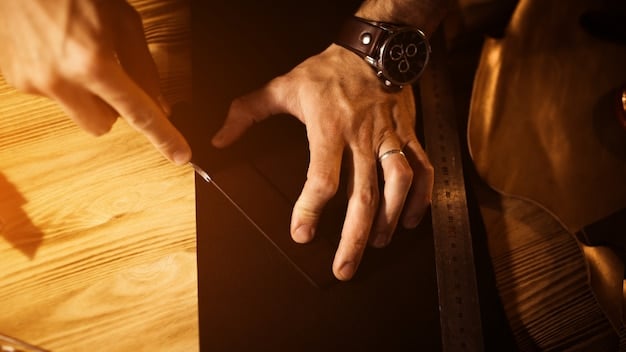
exotic skins: rare and distinguished
Exotic skins represent the pinnacle of luxury in designer footwear, offering unmatched textures, patterns, and a sense of exclusivity. These materials are sourced from various animals, each providing a distinct aesthetic and requiring specialized craftsmanship due to their unique properties.
The use of exotic skins in luxury shoes signifies boldness and a deep appreciation for rare materials. Ethical sourcing is a critical consideration in this segment, with reputable designers ensuring their materials are acquired responsibly and in compliance with international regulations.
crocodile and alligator: reptilian grandeur
Crocodile and alligator skins are celebrated for their distinctive scale patterns and exceptional durability. Alligator skin is generally softer and more pliable, with less pronounced osteoderms (bony plates) compared to crocodile, which boasts a more rugged texture. Both are highly prized for their unique aesthetics.
- unique patterns: Each hide offers a one-of-a-kind scale arrangement.
- durability: Highly resistant to wear and tear, ensuring longevity.
- exclusivity: Commands high prices due to rarity and complex processing.
The intricate processing of these skins, from tanning to finishing, requires specialized techniques to preserve their natural beauty and enhance their luxurious feel. Shoes made from these materials embody a legacy of opulence.
python and snakeskin: serpentine elegance
Python and other snakeskins are admired for their delicate, intricate scale patterns and remarkable flexibility. They offer a lighter alternative to reptilian skins, often used to create shoes with elegant drapes and striking visual appeal. Varieties range from matte to glossy finishes.
Despite their delicate appearance, these skins are surprisingly durable when properly cared for. Their ability to be dyed in a vast array of colors makes them a favorite for designers looking to create bold and artistic pieces. The subtle shimmer of snake scales adds an undeniable allure to any design.
ostrich: textured sophistication
Ostrich leather is easily recognizable by its unique pattern of quill bumps, known as “crown marks.” It is renowned for its softness, flexibility, and exceptional durability, making it comfortable to wear while standing up to rigorous use. Its naturally oily composition helps resist drying and cracking.
This distinct texture provides a luxurious and unconventional alternative to traditional leathers. Ostrich leather’s porous nature allows for deep dye penetration, resulting in vibrant colors that maintain their richness over time. Its character and resilience make it a cherished material in high-end footwear.
The appeal of exotic skins lies not just in their beauty but also in their scarcity and the specialized artisanship required to transform them into wearable art. Each pair crafted from these materials is a testament to luxury and individuality, demanding careful consideration from both designer and wearer.
synthetic innovations and sustainable alternatives
The footwear industry is increasingly embracing synthetic materials and sustainable alternatives, driven by technological advancements and a growing demand for eco-conscious products. These innovations offer compelling options that can mimic the aesthetics and performance of traditional materials while addressing environmental and ethical concerns.
Modern synthetics are often engineered for specific performance attributes, such as water resistance, breathability, or enhanced durability. Meanwhile, bio-based materials are emerging as genuinely disruptive forces, pushing the boundaries of what is possible in sustainable luxury footwear.
vegan leather: ethical sophistication
Vegan leather encompasses a broad category of materials designed to replicate the look and feel of animal leather without using animal products. Traditionally made from polyurethane (PU) or polyvinyl chloride (PVC), newer innovations are exploring plant-based alternatives, significantly reducing environmental impact.
- ethical choice: Provides an animal-friendly alternative.
- design flexibility: Can be produced in a wide range of colors and textures.
- innovation: Constantly evolving with new sustainable developments.
The quality of vegan leather has advanced significantly, with many options now offering impressive durability and aesthetic resemblance to genuine leather. This makes it a viable and attractive option for designers committed to ethical practices.
recycled and bio-based materials: the future of footwear
The frontier of sustainable shoe materials includes recycled plastics (RPET), mushroom leather (Mylo), pineapple leaf fibers (Piñatex), and even apple skins. These materials are at the forefront of the movement towards circular fashion, aiming to reduce waste and reliance on virgin resources.
Recycled materials transform post-consumer waste into new, valuable components for footwear, closing the loop on material lifecycles. Bio-based alternatives, on the other hand, leverage renewable resources, offering compelling performance while minimizing ecological footprints.
These innovative materials are not just about sustainability; they often bring unique properties and textures that inspire novel design approaches. As consumer awareness grows, the adoption of these materials will undoubtedly shape the future of designer shoe manufacturing.
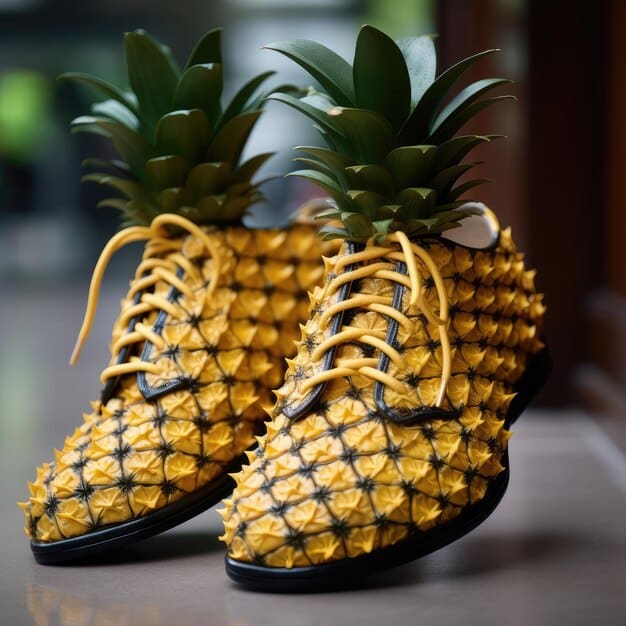
the art of shoe lining and sole materials
Beyond the exterior, the internal components of a designer shoe – the lining and sole – are equally crucial for comfort, durability, and overall quality. These hidden layers play a significant role in the shoe’s breathability, structural integrity, and how it withstands the rigors of wear.
The choice of lining material impacts moisture management and comfort, while the sole determines grip, flexibility, and protection against the elements. Discerning designers meticulously select these internal components to ensure a holistic luxury experience.
linings: comfort and breathability
The material used for the shoe’s lining directly affects the wearer’s comfort and foot health. Leather linings, often calfskin or goat skin, are preferred in luxury shoes for their softness, breathability, and ability to mold to the foot over time, preventing sweat buildup and odor.
Other quality linings include high-tech synthetic fabrics that wick moisture away, providing a dry and comfortable environment. Natural fabrics like cotton or wool can also be used, depending on the shoe’s intended use and design, offering varying levels of warmth and softness.
A well-constructed lining contributes to the shoe’s longevity by protecting the outer material from internal friction and moisture. It signifies attention to detail and reinforces the shoe’s premium status, offering a luxurious feel with every step.
soles: grip, durability, and flexibility
The sole provides foundational support, traction, and protection. High-quality designer shoes typically feature soles made from leather, rubber, or a combination of both, each offering distinct advantages based on the shoe’s function and style.
- leather soles: Offer superior breathability and a classic, elegant appearance. They mold to the foot, providing custom comfort but require care in wet conditions.
- rubber soles: Provide excellent grip, water resistance, and cushioning. Ideal for everyday wear and inclement weather, they are durable and low maintenance.
- hybrid soles: Combine leather and rubber elements to balance traditional aesthetics with enhanced practicality, offering the best of both worlds.
The construction method of the sole, such as Goodyear welting or Blake stitching, also contributes significantly to the shoe’s durability and ability to be resoled. These traditional techniques underscore the commitment to craftsmanship in designer footwear.
Ultimately, the meticulous selection of lining and sole materials is a hallmark of truly luxurious shoes. It ensures that comfort and functionality are seamlessly integrated with the exquisite exterior design, delivering an unparalleled wearing experience.
caring for designer shoe materials
Proper care is essential to preserve the beauty and longevity of designer shoes, regardless of the material. Each type of material, from robust leather to delicate suede and exotic skins, requires specific attention to maintain its pristine condition and protect its investment value.
Neglecting proper care can lead to premature wear, discoloration, and structural damage, diminishing the shoe’s aesthetic appeal and functionality. Investing in the right cleaning and protection products is as important as the initial purchase of the shoes themselves.
leather care essentials
For smooth leather shoes, regular cleaning and conditioning are paramount. Use a soft cloth to wipe away dust and dirt after each wear. Apply a high-quality leather conditioner or cream periodically to moisturize the leather, preventing it from drying out and cracking.
- cleaning: Wipe with a damp cloth, gently removing surface dirt.
- conditioning: Apply leather conditioner to keep material supple.
- polishing: Use shoe polish to restore shine and color, offering protection.
Store leather shoes with shoe trees to maintain their shape and absorb moisture. Keep them away from direct sunlight and extreme temperatures to prevent fading and material degradation. Regular professional cleaning can also extend their life.
suede and nubuck maintenance
Suede and nubuck require a gentler approach. Use a specialized suede brush to remove dirt and restore the nap. For stains, a suede eraser can be effective. Always apply a water and stain repellent spray before the first wear and reapply regularly, especially in damp climates.
Avoid exposing suede and nubuck to excessive moisture, as water can leave permanent marks. If they do get wet, allow them to air dry naturally, away from direct heat, then brush gently once dry. Special cleaning products are available for deeper stains.
exotic skin preservation
Exotic skins demand bespoke care. Use a soft, lint-free cloth to dust them gently. For crocodile and alligator, a specialty exotic leather conditioner can help maintain softness and prevent scales from drying. Python and snakeskin may need a specific product to condition the scales.
Always wipe exotic skins in the direction of the scales to avoid lifting or damaging them. Store these shoes in breathable dust bags to protect them from dust and friction. Avoid harsh chemicals and excessive moisture, as they can cause irreparable damage to these delicate materials.
Implementing a consistent care routine for all designer shoe materials not only extends their lifespan but also ensures they continue to look their best. It’s an investment in preserving the craftsmanship and luxury that define high-end footwear.
the impact of craftsmanship on material integrity
The inherent quality of a designer shoe material is only fully realized through exceptional craftsmanship. Skilled artisans, with their deep understanding of various materials, transform raw components into wearable art. Their expertise ensures that each material’s unique properties are honored and maximized.
From the precise cutting of hides to meticulous stitching and finishing, every step in the shoemaking process speaks to the level of craftsmanship. It’s this fusion of high-quality materials with expert artistry that truly defines a luxurious pair of designer shoes.
precision cutting and stitching
The way a material is cut and sewn significantly impacts the finished shoe’s aesthetic and durability. Precision cutting minimizes material waste and ensures symmetrical components. Hand-stitching, a hallmark of high-end shoes, offers superior strength and a refined finish.
Artisans consider the grain of leather, the direction of nap in suede, or the patterns of exotic skins when cutting, ensuring the material performs and looks its best. The choice of thread and stitching technique complements the material, promoting longevity and structural integrity.
structural integrity and lasting
The lasting process, where the upper of the shoe is shaped over a “last” (a foot-shaped form), is critical for ensuring the shoe’s fit and comfort. This process requires a deep understanding of how each material stretches and molds, guiding it into the desired shape without overstressing its fibers.
A well-lasted shoe maintains its form over time, preventing creasing and contributing to overall durability. The interplay between the material’s properties and the artisan’s skill in lasting directly influences the shoe’s comfort and ability to retain its elegant silhouette.
hand-finishing techniques
The final touches, often applied by hand, are what set designer shoes apart. Techniques like hand-burnishing, patinating, and edge finishing bring out the material’s richness and create a unique character. These details are labor-intensive but result in a superior product.
Whether it’s creating a subtle antique effect on leather or meticulously polishing exotic skins, these finishing techniques enhance the material’s natural beauty and protect it. They transform a well-made shoe into a masterpiece, reflecting both the material’s potential and the artisan’s dedication.
In essence, the dialogue between high-quality materials and unparalleled craftsmanship is what elevates designer shoes. Each piece is not just an accessory but a testament to a heritage of skill, patience, and an unwavering commitment to luxury and durability, ensuring that the material’s integrity shines through in every detail.
| Key Material | Brief Characteristic |
|---|---|
| 🐄 Full-Grain Leather | Top quality, durable, develops rich patina. |
| ☁️ Suede & Nubuck | Velvety texture, soft feel, requires delicate care. |
| 🐊 Exotic Skins | Unique patterns, high luxury, specialized care. |
| ♻️ Vegan & Recycled | Ethical alternatives, growing sustainability. |
frequently asked questions
▼
Full-grain leather is widely considered the most durable material for designer shoes. It retains the hide’s natural grain and strength, making it highly resistant to wear and tear. When properly cared for, full-grain leather shoes can last for decades, developing a beautiful patina over time that enhances their aesthetic appeal and character.
▼
To clean suede designer shoes, use a specialized suede brush to gently remove dirt and restore the nap. For stains, a suede eraser can be effective. Always apply a water and stain repellent spray before first wear and reapply regularly. Avoid water and allow wet shoes to air dry naturally, away from direct heat.
▼
The quality of vegan leather designer shoes has significantly improved, with many options offering impressive durability and aesthetic resemblance. While traditional PU/PVC vegan leathers might not match the longevity of full-grain, newer plant-based alternatives are closing the gap, providing ethical and increasingly high-quality options for luxury footwear.
▼
Exotic skins, such as crocodile, python, and ostrich, offer unique textures, patterns, and a sense of exclusivity that set them apart. They are highly prized for their distinctive aesthetics and inherent durability, often making a bold fashion statement. Their rarity and specialized craftsmanship contribute to their high value and luxurious appeal.
▼
The shoe lining material is crucial for comfort, breathability, and foot hygiene. Quality linings, often made from soft leather like calfskin, absorb moisture, allow air circulation, and conform to the foot over time. This prevents sweat buildup, reduces odor, and contributes significantly to the shoe’s overall comfort and durability, enhancing the luxury experience.
conclusion
The journey through the intricate world of designer shoe materials underscores that true luxury is found not just in design, but in the intelligent selection and masterful handling of textiles. From the enduring strength of full-grain leather to the soft embrace of suede, the audacious allure of exotic skins, and the promise of innovative sustainable alternatives, each material brings a unique narrative to the craft of shoemaking. Understanding these foundational elements empowers the wearer to make informed choices, appreciate the artistry, and ensure the longevity of their cherished footwear. It’s a commitment to quality that transcends trends, ensuring every step is a testament to both style and substance.
